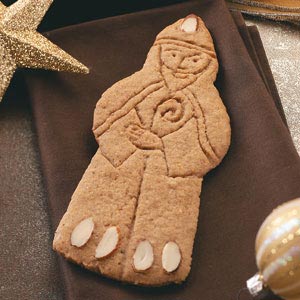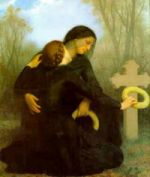Catholic Recipe: Speculaas or Speculatius III

Also Called: Speculaas, Speculaus, St. Nicholas Cookies, Kris Kringle Cookies, Dutch spice cookies
Although St. Nicholas is not in the illustrious company of the Fourteen Auxiliary Saints, he has been one of the most popular saints in the East and in the West for many hundreds of years. He is the patron of seafarers and also of scholars, bankers, and — thieves. But most of all, he is the very special saint of children. Devotion to St. Nicholas is found in every European country. In the north, in Scandinavia and in northern Germany, he is known as Santa Claus. I do not know what happened to him on his way from Europe to America. While he is still pictured in the old world as an ascetic-looking bishop with cope, mitre, and crozier, since crossing the ocean he has turned into a fat, jolly, red-nosed, elderly gentleman in a snowsuit and a red cap. From Lapland he has brought his reindeer. Unfortunately, he has changed the date of his appearance. In the old country he comes on the evening before his feast day (the feast of St. Nicholas, on December 6th), accompanied by the "Krampus," an ugly, chain-rattling little devil, who has to deal with the children who have been naughty. St. Nicholas is much too kind to do the punishing and scolding himself.
It all goes back to the days when St. Nicholas was Bishop of Myra, where he once discreetly threw alms in through a window as a dowry for three young girls, who would otherwise have been sold into slavery, according to the custom of the day. For this good deed God rewarded him by giving him permission to walk the streets of earth on the eve of his feast, bringing gifts to all good children.
While in some places the children only put their shoes on the window sill on the eve of St. Nicholas' Day and find them filled with candies, cookies, oranges, and dried fruit the next morning (but only the good ones; the bad ones find a switch), in other parts St. Nicholas comes in person. He always did in our house. On the eve of December 5th the whole family would gather in the living room with great expectancy. By the time the much-expected knock at the door could be heard, one could almost hear the anxious heartbeat of the little ones. The holy bishop, in his pontifical vestments, accompanied by Krampus, would enter the room while everybody stood up reverently. St. Nicholas always carried a thick book in which the Guardian Angels make their entries throughout the year. That's why the saint has such an astonishing knowledge about everybody. He calls each member of the household forward, rewarding the good and admonishing the less good. The good children will get a package of sweets, whereas Krampus aims at the legs of the children who did not deserve one. After everyone has received his due, the holy bishop addresses a few words of general admonition to the whole family, acting as a precursor to the One Who is to come, drawing their thoughts toward Christmas, asking them to prepare their hearts for the coming of the Holy Child. After giving his blessing, he takes his leave, accompanied reverently by the mother, who opens the door for him. Soon afterwards the father, who, oddly enough, usually misses this august visit, will come home, and he has to hear everything about it from the youngest in the house.
Of course it did not occur to us, even in the first and second years in America, that St. Nicholas' Day should pass without the dear saint's appearing in our family circle. In the old home this beloved bishop's attire was stored away in the attic to be used every year on the evening before his feast, but now we had to work with cardboard and paper for the mitre, a bed sheet for an alb, a golden damask curtain borrowed from friends for a cope, and a broomstick artistically transformed into a bishop's staff. But at the right moment St. Nicholas opened the door. That taught us that it really does not require money, but only imagination and good will, to revive or introduce these lovely old customs.
"St. Nicholas smells of Christmas, don't you think, Mother?" one of my little girls said once, meaning that on December 5th the whole house was filled with the same good smell as it would be in the days just before Christmas. For this day there is a special kind of cookie called Speculatius. The dough is rolled very thin and then cut in the shape of St. Nicholas, and these little figures are then decorated with icing in different colors and candied fruit. And just as we are sharing with the reader our ancient songs and customs, I believe we should also share those ancient recipes that have come down to us through the centuries. So here is the recipe for Speculatius (St. Nicholas). It comes from Holland.
DIRECTIONS
Cream the butter, lard, and sugar. Add sour cream alternately with sifted dry ingredients. Stir in nuts. Knead the dough into rolls. Wrap the rolls in waxed paper and chill in the refrigerator overnight. Roll the dough very thin and cut it into shapes. Bake in moderate oven 10 to 15 minutes.
Recipe Source: Around the Year with the Trapp Family by Maria Augusta Trapp, Pantheon Books Inc., New York, New York, 1955





